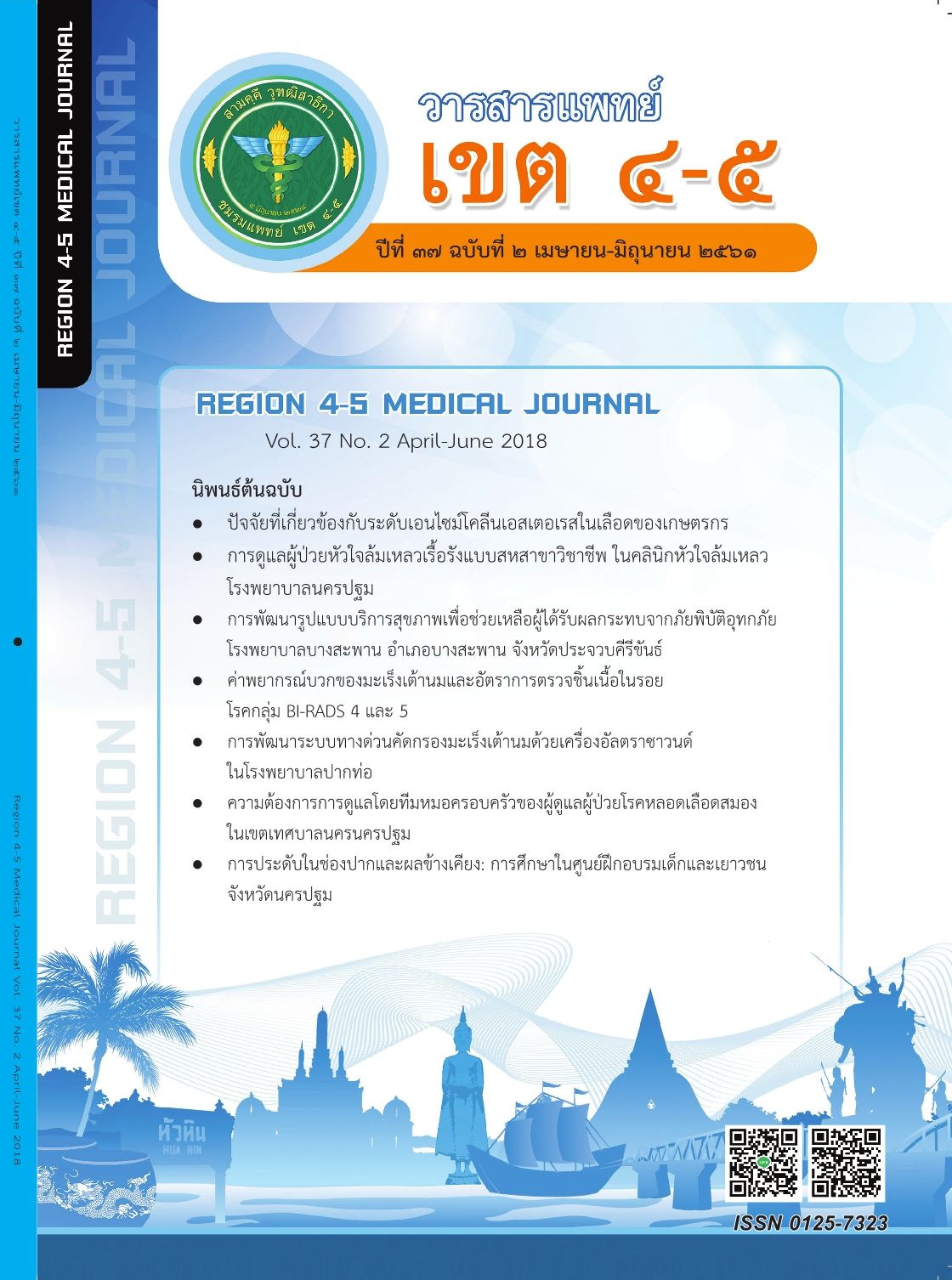ความเหมาะสมของการใช้เลือดและปัจจัยที่มีผลกับการได้รับเลือดหลังผ่าตัด สำหรับผู้ป่วยที่มารับการผ่าตัดเปลี่ยนข้อเข่าเทียมในโรงพยาบาลดำเนินสะดวก
คำสำคัญ:
ความเหมาะสมของการใช้เลือด, การผ่าตัดเปลี่ยนข้อเข่าเทียม, การได้รับเลือดหลังผ่าตัดบทคัดย่อ
วัตถุประสงค์: เพื่อประเมินความเหมาะสมของการใช้เลือดและศึกษาหาปัจจัยที่มีผลกับการได้รับเลือดหลังผ่าตัด สำหรับการผ่าตัดเปลี่ยนข้อเข่าเทียมในโรงพยาบาลดำเนินสะดวก
วิธีการศึกษา: การศึกษาแบบพรรณนา โดยเก็บข้อมูลย้อนหลังจากเวชระเบียนผู้ป่วยที่เข้ารับการผ่าตัดเปลี่ยนข้อเข่าเทียมตั้งแต่วันที่ 1 เดือนตุลาคม 2557 ถึงวันที่ 30 เดือนกันยายน 2560 นำเสนอข้อมูลเป็นจำนวน ร้อยละ ค่าเฉลี่ย และส่วนเบี่ยงเบนมาตรฐาน วิเคราะห์ปัจจัยที่มีผลกับการได้รับเลือดหลังผ่าตัดด้วย t-test independent, chi-square test และเปรียบเทียบสัดส่วนความเสี่ยง (odds ratio) ระหว่างกลุ่มที่ได้รับเลือดกับกลุ่มที่ไม่ได้รับเลือด ด้วยการวิเคราะห์ binary logistic regression และการประมาณค่าขอบเขตความเชื่อมั่นร้อยละ 95 (95% confidence interval: 95% CI)
ผลการศึกษา: จำนวนผู้ป่วยทั้งหมด 136 ราย พบว่ามีการเตรียมเลือดเพื่อการผ่าตัดจำนวน 287 ยูนิต มีการใช้เลือดจริงจำนวน 85 ยูนิต สำหรับผู้ป่วย 58 ราย crossmatch to transfusion ratio (C/T ratio) เท่ากับ 3.38 กลุ่มที่ได้รับเลือดมีน้ำหนัก ดัชนีมวลกาย (p<0.05) ค่าฮีโมโกลบินและค่าฮีมาโตคริตก่อนผ่าตัด (p<0.001) น้อยกว่ากลุ่มที่ไม่ได้รับเลือดอย่างมีนัยสำคัญทางสถิติ โดยค่าฮีมาโตคริตก่อนผ่าตัดเป็นปัจจัยที่สำคัญที่สุด (OR=0.696, 95% CI=0.507-0.954, p=0.024) ส่วนอายุ เพศ ASA physical status ระยะเวลาการผ่าตัดและการหนีบสายระบายเลือดไม่มีผลกับการได้รับเลือดหลังผ่าตัด
สรุป: การใช้เลือดสำหรับการผ่าตัดเปลี่ยนข้อเข่าเทียมอยู่ในเกณฑ์ไม่เหมาะสมจึงควรเตรียมเลือดแบบ type and screen และปัจจัยที่มีผลกับการได้รับเลือดหลังผ่าตัด คือ น้ำหนัก ดัชนีมวลกาย ค่าฮีโมโกลบินและค่าฮีมาโตคริตก่อนผ่าตัด
References
2. สิทธิพร ดีทายาท. การลดค่าใช้จ่ายในการเตรียมเลือดเพื่อการผ่าตัดศัลยกรรมระบบประสาท กรณีไม่เร่งด่วนในโรงพยาบาลราชบุรี. วารสารแพทย์เขต 4-5 2558;34:26-34.
3. สมฤทธิ์ มหัทธโนบล, สมเกียรติ สรรพวีรวงศ์. ผลของแนวทางการจองเลือดสำหรับการผ่าตัดกรณีไม่ฉุกเฉินทางศัลยกรรมที่โรงพยาบาลสงขลานครินทร์. สงขลานครินทร์เวชสาร 2551;26:491-500.
4. Bhutia SG, Srinivasan K, Ananthakrishnan N, et al. Blood utilization in elective surgeryRequirement, ordering and transfusion practices. Nati Med J India 1997;10:164-8.
5. Kumari S, Kansay RK, Kumar S. Proposed maximum surgical blood ordering schedule for common orthopedic surgeries in Tertiary Health-Care Center in Northern India. J Orthop Allied Sci 2017;5:21-6.
6. Mahar FK, Moiz B, Khurshid M, et al. Implementation of Maximum Surgical Blood Ordering Schedule and Improvement in Transfusion Practices of Surgeons subsequent to Intervention. Indian J Hematol Blood Transfus 2013;29:129-33.
7. จุมภฏพงษ์ วงษ์เอก, ศุภมาศ ลิ่วศิริรัตน์, อุรวิศ ปิยะพรมดี. การศึกษาความคุ้มค่าของการจองเลือดสำหรับผ่าตัดทางออร์โธปิดิกส์ที่ไม่ฉุกเฉินของโรงพยาบาลมหาราชนครราชสีมา. วารสารราชวิทยาลัยแพทย์ออร์โธปิดิกส์แห่งประเทศไทย 2558;39:17-24.
8. กัญญา พานิชกุล, โกรวาส แจ้งเสม, วราภรณ์ เชื้ออินทร์ และคนอื่นๆ. ความคุ้มค่าในการเตรียมเลือดเพื่อผ่าตัดวิธีปกติ (routine cross-match) สำหรับผู้ป่วยที่มารับการผ่าตัดศัลยกรรมข้อเข่าและข้อสะโพกในกรณีไม่เร่งด่วน. ศรีนครินทร์เวชสาร 2557;29:423-8.
9. Lee QJ, Mak WP, Yeung ST, et al. Blood management protocol for total knee arthroplasty to reduce blood wastage and unnecessary transfusion. J Orthop Surg (Hong Kong) 2015;23:66-70.
10. Tay YWA, Woo YL, Andrew Tan HC. Routine pre-operative group cross-matching in totalknee arthroplasty: A review of this practice in an Asian population. The Knee 2016;23:306-9.
11. Lyer SS, Shah J. Red blood cell transfusion strategies and Maximum surgical blood ordering schedule. Indian J Anaesth 2014;58:581-9.
12. Noticewala MS, Nyce JD, Wang W, et al. Predicting need for allogeneic transfusion after total knee arthroplasty. J Arthroplasty 2012;27:961-7.
13. Mufarrih SH, Qureshi NQ, Ali A, et al. Total knee arthroplasty: risk factors for allogeneic blood transfusions in the south Asian population. BMC Musculoskelet Disord 2017;18:359.
14. Mesa-Ramos F, Mesa-Ramos M, Maquieira-Canosa C, et al. Predictors for blood transfusion following total knee arthroplasty: a prospective randomized study. Acta Orthop Belg 2008;74:83-9.
15. Hart A, Khalil JA, Carli A, et al. Blood transfusion in primary total hip and knee arthroplasty: Incidence, risk factors, and thirty-day complication rates. J Bone Joint Surg Am 2014;96:1945-51.
16. Salido JA, Marin LA, Gomez LA, et al. Preoperative hemoglobin levels and the need fortransfusion after prosthetic hip and knee surgery: analysis of predictive factors. J Bone Joint Surg Am 2002;84-A:216-20.
17. Bong MR, Patel V, Chang E, et al. Risks associated with blood transfusion after total knee arthroplasty. J Arthroplasty 2004;19:281-7.
18. Chareancholvanich K, Siriwattanasakul P, Narkbunnam R, et al. Temporary clamping of drain combined with tranexamic acid reduce blood loss after total knee arthroplasty: a prospective randomized controlled trial. BMC Musculoskelet Disord 2012;13:124.
19. Stucinskas J, Tarasevicius S, Cebatorius A, et al. Conventional drainage versus four hour clamping drainage after total knee arthroplasty in severe osteoarthritis: a prospective, randomized trial. Int Orthop 2009;33:1275-8.
20. Jeon YS, Park JS, Kim MK. Optimal release timing of temporary drain clamping after total knee arthroplasty. J Orthop Surg Res 2017;12:47.
Downloads
เผยแพร่แล้ว
How to Cite
ฉบับ
บท
License
ลิขสิทธิ์บทความเป็นของผู้เขียนบทความ แต่หากผลงานของท่านได้รับการพิจารณาตีพิมพ์ลงวารสารแพทย์เขต 4-5 จะคงไว้ซึ่งสิทธิ์ในการตีพิมพ์ครั้งแรกด้วยเหตุที่บทความจะปรากฎในวารสารที่เข้าถึงได้ จึงอนุญาตให้นำบทความในวารสารไปใช้ประโยชน์ได้ในเชิงวิชาการโดยจำเป็นต้องมีการอ้างอิงถึงชื่อวารสารอย่างถูกต้อง แต่ไม่อนุญาตให้นำไปใช้ในเชิงพาณิชย์



